Website as a digital business card vs. website as a sales channel
Whether as a marketing tool, for employer branding, for acquiring new customers or as a digital sales channel - a professional website tailored to the company has become indispensable in both the B2C and B2B context. Companies focus on different goals: for example, the website should be easy to find in Google, have a particularly eye-catching design or display a lot of information clearly.
In principle, all websites can be divided into two categories: digital business card and digital sales channel.
But what exactly is the difference, what are the advantages and disadvantages and what makes the most sense for the respective company?
Website as a business card
Websites that are used as business cards are also called one-pagers. They have no subpages and therefore do not require navigation or a menu. The content, such as text or images, is therefore displayed on a single page.
What works particularly well with a one-page website is what is known as storytelling. This is because the visitor is guided from the top to the bottom of the page with the help of interesting content and does not have to click through various pages.
Advantages of a one-pager as a company website
- Simple and quick implementation
- Services are presented in a compact form
- Modern design thanks to structured and legible content
- Clear reading flow has a positive effect on user experience & usability
- Flexible design is particularly suitable for smartphones
Disadvantages of a one-pager as a company website
- Only a limited amount of information can be displayed
- Too much content on different topics within the one-pager weakens SEO
- Optimizing onepagers for search engines is more difficult than with a larger website with subpages
What to look out for on a one-page website
If too many images are used, the company website can quickly appear confusing. Animations or graphics that improve orientation on the page are better.
Jump labels, which can be used as a kind of substitute navigation or within the text, for example, create clear structures and also make it easy to switch between different subject areas.
In terms of search engine optimization, content on just one topic should ideally be found on the page.
Lazy load" should be used to shorten loading times. This means that content is only loaded when the user scrolls to this point.
Here is an example from our customer Herrenknecht:
Website as a sales channel
In contrast to a one-page website, potential customers are acquired via the website as a sales channel. These company websites are more complex due to the various subpages and present both the company and the products or services in detail. The website is also structured in such a way that customers are accompanied along the customer journey in the best possible way. This means that customers are guided to relevant pages that provide all the information they need to purchase a product or service.
Website as a sales channel - advantages
- Easy option for internationalization compared to other sales channels
- Initial contact, support and an online store can be integrated into the website and serve as sales support
- Search engine optimization can be implemented
- Important data can be collected and evaluated by analyzing users
Website as a sales channel - disadvantages
- Complex and time-consuming
- Difficult for non-professionals to implement above a certain level
- Clear concept recommended
- External help recommended
What to look out for in a digital sales channel
The website should be found in search engines using relevant search terms for the previously defined target group.
It must provide all the information that a potential customer is looking for and can influence their purchase decision.
Particular attention should be paid to the user-friendliness of a complex website. If there are too many subpages or information is difficult to find, the user experience suffers, which can lead to high bounce rates.
A particularly important area for websites that are used as a sales channel is support. Customers should have a direct contact person if individual questions cannot be answered on the website.
3 steps to a digital sales channel
- Arouse customer interest
Present content that is of interest to customers - Navigate customers
Create a clear structure so that customers can easily find their way around - Convince customers
Integrate a contact form or call-to-action so that customers have the opportunity to get in touch or request further information.
This is what a website as a sales channel could look like for our customer Winterhalter:
What is suitable for which company or which product?
Website as a business card
- Suitable for large backgrounds from a design perspective
- Often used by companies that only have one product or service
- For local businesses, such as restaurants, or for products that require little explanation, such as apps
- Ideal for start-ups that can set up their website themselves in just a few steps
- One-pagers can also be used as a campaign page or landing page within another website
Website as a sales channel
- Suitable for companies looking for a new way to acquire customers
- For companies with complex products or services or a comprehensive product portfolio
- Perfect for B2B companies, as the services usually require more explanation
